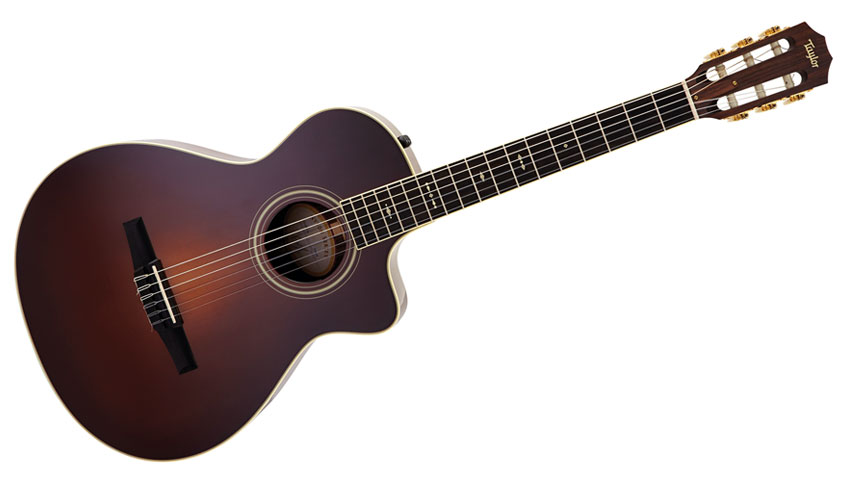MusicRadar Verdict
Taylor's take on the hybrid steel/nylon guitar is extremely playable with a mellow acoustic voice and crisper, more attacking amplified sound.
Pros
- +
Build. Vintage styling. Playability. Acoustic sound.
Cons
- -
Can we have an ES system for the nylon-strings, please?
MusicRadar's got your back
Taylor, despite building guitars since 1974, is still seen as the very modern opposite to Martin's oh-so-vintage style. That perception will probably never change, but this year's Taylor line features the overhauled 700 Series that, "with their vintage sunburst tops and ivoroid heritage fretboard inlays conjure a distinctively old-school Americana vibe".
The 381mm (15-inch) wide body size puts Taylor's grand concert in the same ballpark as Martin's 000/0M and, for 2012, the 700 series has an Engelmann spruce top with Indian rosewood back and sides - all solid, of course - with tropical mahogany necks, ebony fingerboards and bridges.
"The rich brown finish is perfectly contrasted by grained ivoroid binding around the top and back edge"
It has a very dark brown, gloss-finished top with a brighter orange 'sun' in the centre. A similarly hued 'burst is applied to the neck back while the rosewood is left natural gloss. This rich brown is perfectly contrasted by grained ivoroid binding around the top and back edge, and also along the fingerboard edges.
Cosmetic embellishments are tastefully sparse: black/white purfling inside the top's edge binding, a very thin purfling strip covering the two-piece back's centre joins, three-ring ivoroid/purfling soundhole ring and the same ivoroid inlays at the 5th, 7th, 9th, 12th and 15th fret fingerboard positions.
The guitar has a headstock-end truss rod adjuster and, of course, it uses Taylor's NT bolt-on neck. The fret ends sit over the binding with a 508mm (20-inch) radius.
The nylon string 712ce-N uses a broad, unbound slot headstock; it's a 12-fret style with a scale of 648mm (25.5mm). We have a classical-style fan bracing and three back braces.
Conceived as a nylon-string guitar for the steel-string player the neck is fairly wide - 48.1mm nut width, 41mm string spread and a wide 54.5mm string spacing at the classical-style bridge.
Want all the hottest music and gear news, reviews, deals, features and more, direct to your inbox? Sign up here.
Depth-wise, the profile is a flat-ish C. The ES-N pickup system uses a proprietary undersaddle transducer - there are no body sensors - with a preamp and trio of controls and there's a battery indicator LED and phase slide switch for feedback control.
Sounds
"The wide neck is easy to adjust to and intonation and playability are superb"
The 712ce-N exhibits the intimacy and balance of a steel string. The wide neck is easy to adjust to and intonation and playability are superb. It feels very different to a concert classical and sounds very different, too - less bright-edged and explosive. Its unplugged sound suggests a much more laid-back style: a seriously good Latin/jazz nylon string. The string tension isn't over-soft either - it's very engaging, albeit far from its Spanish roots.
If it sounds a little 'polite' acoustically, when plugged in we encounter a brighter voice and a harder attack: but the crispness (and wound string noise) is hard to tame down. Compared to Yamaha's NCX2000, the 712ce-N lacks a little lower-mid thickness, too. Certainly, dialling in some lower mids and reducing the high-end from an outboard preamp pedal creates a much more usable amp'd tone, but we can't help thinking that a slightly more specific treble EQ - or maybe an additional HF damping switch on the PCB - could improve things.
Taylor's nylon strings are a relatively newer prospect and again while the build, feel and playability of the 712ce-N, in terms of a hybrid steel/nylon, is superb, it's the amplified sound that takes a little work.
Still, factor in the very cool visual aesthetic, effortless playability and what is a just-about realistic price for a premium USA guitar of this quality, and you still have a hugely attractive instrument.
Dave Burrluck is one of the world’s most experienced guitar journalists, who started writing back in the '80s for International Musician and Recording World, co-founded The Guitar Magazine and has been the Gear Reviews Editor of Guitarist magazine for the past two decades. Along the way, Dave has been the sole author of The PRS Guitar Book and The Player's Guide to Guitar Maintenance as well as contributing to numerous other books on the electric guitar. Dave is an active gigging and recording musician and still finds time to make, repair and mod guitars, not least for Guitarist’s The Mod Squad.

